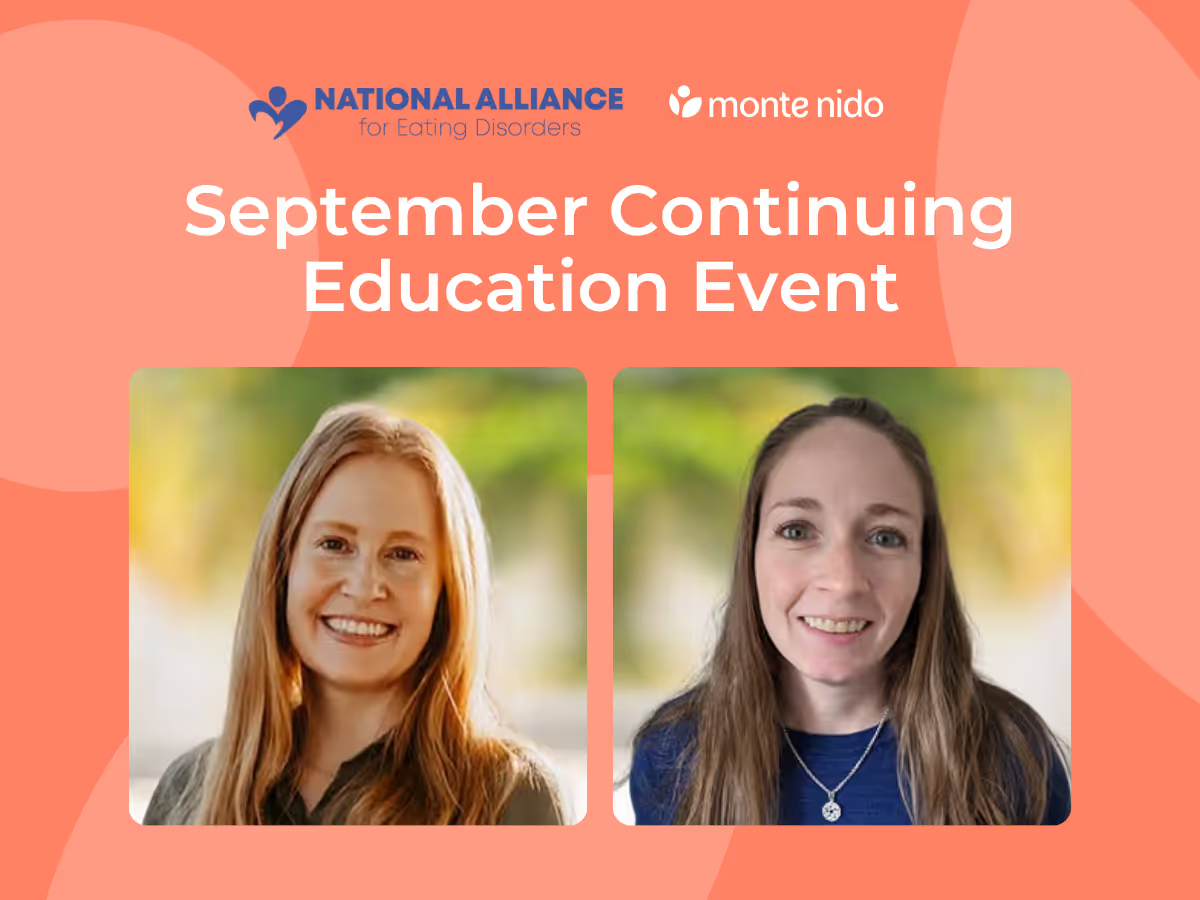On September 19th, Monte Nido Executive Director of Virtual Adolescent Programs Amanda Smith, LICSW, LCSW, LCSW-C, CEDS and Monte Nido VP of Virtual Programs Tiffany King, MBA, presented “Best Practice in Moving the Eating Disorder Field Forward with Virtual Care" in collaboration with MEDA Multi-Service Eating Disorders Association.
Virtual treatment has quickly become a cornerstone of mental health care. With updated federal regulations, expanded state compacts, and evolving best practices, access to eating disorder treatment via telehealth is broader than ever.
At Monte Nido, we recognize both the advantages and limitations of virtual care, and we’re committed to ensuring it remains effective, safe, and client-centered.
Shifting Regulations Expand Access to Virtual Health Treatment
Recent updates to DEA and Medicare policies reflect a strong shift toward long-term telehealth accessibility:
- Medicare permanent access: Patients can receive mental health care from home, with no geographic limits. Audio-only visits are allowed, and more providers are eligible. (DEA Announces
- In-person waiver: The requirement for in-person visits every 6–12 months is suspended through Sept. 30, 2025. (DEA Announces, U.S. Department of Health and Human Services)
- DEA prescribing flexibilities: Through Dec. 31, 2025, DEA-registered physicians may prescribe Schedule II–V medications via telehealth without an initial in-person exam. (DEA Announces)
State parity laws also expand access, though there are no uniform national standards for private or state-funded payers. Currently:
- Coverage/service parity: Telehealth must cover the same services as in-person care, though payment rates may differ.
- Telehealth payment parity: In 44 states, D.C., Puerto Rico, and the Virgin Islands, visits must be reimbursed at the same rate as in-person sessions. (CHG Healthcare)
Licensure barriers are easing too, with multi-state compacts:
- Interstate Medical Licensure Compact: Simplifies multi-state licensing for physicians.
- PSYPACT: Active in 40 states for psychologists.
- Counseling Compact: Passed in 39 states, expected to go into effect Fall 2025. (Counseling Compact.)
- Dietitian Licensure Compact: Commission being formed, with nine states joined as of Fall 2025.
Benefits of Virtual Treatment for Eating Disorders
Virtual care strengthens eating disorder recovery by allowing clients to integrate treatment directly into their daily lives. Benefits of virtual health treatment include:
Returning Home with Support
One of the clearest benefits of virtual treatment for eating disorders is the ability to integrate recovery directly into the home environment. Clients practice new skills in real time while receiving feedback from their care team. Family members and loved ones can join sessions without disrupting daily routines, reinforcing recovery at home while maintaining connection to treatment.
Specialized Care Opportunities
Virtual eating disorder care also expands access to specialized support. In-person programs can be limited by geography, but telehealth makes it possible to create treatment groups based on age, diagnosis, or other shared needs. This allows clients to connect with peers who truly understand their experiences, while benefiting from the expertise of a multidisciplinary team. Research consistently shows that group cohesion is one of the strongest predictors of positive therapeutic outcomes. (Burlingame et al.)
Comfort, Connection, and Convenience
Finally, comfort, connection, and convenience are hallmarks of virtual eating disorder care. Clients participate from familiar surroundings, reducing stress and anxiety that often accompany new environments. Those living in rural areas—or with busy schedules—can access treatment without the burden of travel. Families and caregivers are also able to connect more consistently, building a stronger network of support.
Challenges of Virtual Eating Disorder Treatment
Virtual eating disorder treatment does bring challenges that require proactive solutions:
Ambivalence and Commitment
Despite its advantages, virtual eating disorder treatment also presents challenges. Some clients struggle with ambivalence toward recovery, which can make consistent attendance and engagement difficult. This sometimes leads to treatment burnout or premature discharge. Programs can help reduce these risks through careful preparation: reviewing paperwork and insurance coverage before treatment begins, walking families through technology setup, and addressing barriers to reimbursement that could interrupt care.
Technology and Access
Technology itself is another hurdle. Limited access to reliable internet or devices, glitches during sessions, and digital literacy gaps can interfere with treatment. Confidentiality is also harder to ensure when clients participate from home.
Providers can mitigate these challenges by offering technical support, encouraging the use of headphones or private spaces, and connecting families with resources such as community centers or libraries for confidential access.
Safety Concerns
Safety is a third concern. It can be harder to assess or de-escalate risks in a virtual setting, and subtle warning signs may go unnoticed on screen. Programs often address this by positioning cameras to maximize visibility, involving caregivers in monitoring for early signs of distress, and ensuring that providers know local crisis numbers and procedures for wellness checks.
Best Practices for Engagement and Safety in Virtual Treatment Programs
Engagement is one of the strongest predictors of treatment success, and it directly supports client safety. Best practices include:
- Keep groups consistent and no larger than 15 clients.
- Ensure group leaders are trained to “read the room” virtually and foster peer accountability.
- Offer specialized tracks (e.g., FBT, LGBTQ+) to ensure inclusivity.
- Use Zoom or other secure platforms to monitor transitions between sessions.
- Track absences and disengagement closely, with timely staff follow-up.
On the operational side, programs should:
- Conduct thorough virtual intake assessments.
- Adapt evidence-based interventions to telehealth.
- Create crisis response plans with local emergency contacts.
- Verify client location at every session.
- Coordinate regularly among multidisciplinary teams.
- Stay current on evolving telehealth regulations.
Virtual Eating Disorder Treatment Expands Access and Impact
Virtual eating disorder treatment is not a replacement for in-person care, but it has become a vital tool in the continuum of eating disorder recovery. By expanding access, offering specialized groups, and reducing barriers for families, telehealth brings care within reach for many who would otherwise go without.
When challenges are met with thoughtful preparation and best practices, virtual treatment can be both safe and deeply effective.
Explore Monte Nido’s Virtual Eating Disorder Programs
Monte Nido’s virtual eating disorder programs bring specialized, evidence-based care directly to you. With options for adults and adolescents, our programs provide flexible scheduling and individualized treatment for a range of needs, including ARFID, binge eating disorder, LGBTQIA+ support, and family-based treatment.
Backed by more than a decade of research, clients work with a dedicated care team who is committed to guiding each step of the recovery journey. Virtual care at Monte Nido makes lasting recovery both accessible and personalized.
- DEA Announces Three New Telemedicine Rules that Continue to Open Access to Telehealth Treatment while Protecting Patients, https://www.dea.gov/press-releases/2025/01/16/dea-announces-three-new-telemedicine-rules-continue-open-accessv
- U.S. Department of Health and Human Services. (2025, March 15). Telehealth policy updates. https://telehealth.hhs.gov/providers/telehealth-policy/telehealth-policy-updates
- CHG Healthcare. (2025, August 12). Telehealth rules and regulations: 2025 healthcare toolkit. https://chghealthcare.com/blog/telehealth-rules-regulations#:~:text=Update%20to%20Medicare%20telehealth%20rules,non%2Dbehavioral/mental%20telehealth%20services
- Counseling Compact. (n.d.). Counseling compact map. https://counselingcompact.gov/map/
- Burlingame et al. (2011, 2018)




.svg)


.avif)
